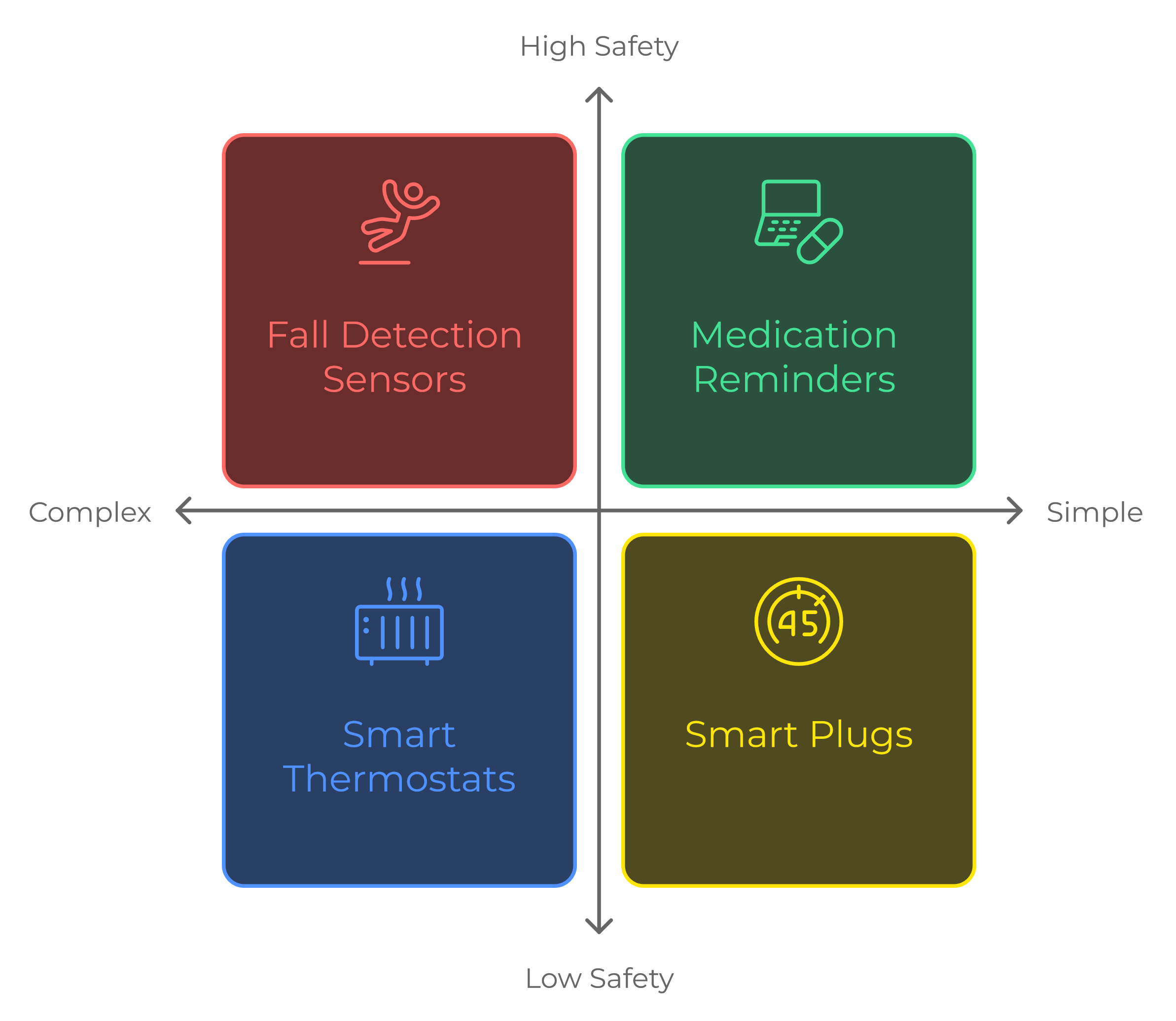Aging in Place: How Smart Homes Empower Independent Living for Seniors
People worldwide are living longer

People worldwide are living longer. The WHO has a fact sheet with some very interesting figures:
In 2020, the number of people aged 60 years and older outnumbered children younger than 5 years.
Between 2015 and 2050, the proportion of the world's population over 60 years will nearly double from 12% to 22%.
Generally, as we age, we need a little bit of help with certain daily tasks. But there is also a strong desire for independent living. People want to keep a sense of day-to-day control.
At DataSolace, we know the solution to this problem is the smart home. Automations can perform certain functions without having to rely on residents' memories. Monitoring devices can detect falls, heat build-up, and dangerous CO/CO2 accumulation. The evolution of the smart home is only beginning, and we can't wait for what the future holds.
The Challenges of Aging in Place
Popular science educators such as Peter Attia have been shouting the dangers at us for a while. "If you're over 65 and you fall and break your hip, there is a 30-40% chance you will be DEAD in 12 months." You've likely heard the quote "what gets measured gets managed." You might wonder: why not track aging people's progression to identify issues early? With a variety of modern sensors in the smart home, we're beginning to see that possibility.
And that's not all! Medications escape the user's memory. A shrinking social circle can lead to feelings of isolation. Technology can solve, or at least improve, the vast majority of these issues.
Smart Homes vs. Traditional Homes for Seniors
Imagine your home as a health companion. Lights pulse a gentle reminder each morning. A soft voice prompts, "Time for meds." No response by 10 AM? Your smart home shifts hues, a visual cue impossible to miss. This seamless system replaces the easy-to-miss pillbox. It weaves in reminders to take medication into your daily routine. Pretty hard to forget that!
A voice rings out as you tumble: "Have you fallen?" No more lying helpless, regretting a forgotten safety pendant. Call out to receive instant help. Your smart home sends caregivers prompt notifications, eliminating lengthy delays. Swift aid and tranquillity await the vulnerable. This smart system revolutionizes emergency care, offering rapid support when it matters most.
Key Smart Home Tools and Devices for Seniors
Motion sensors are a key smart home tool. Modern millimetre wave sensors can detect presence. They are also crucial for detecting falls. Doorbell innovation marries security with ease. Visual alerts and sounds notify homeowners of visitors. They boost safety and streamline daily life. Combined with smart locks, they even reduce the physical burden of answering the door.
Alexa and Google Home can help with tasks and provide companionship. Smart thermostats adjust temperatures for comfort and energy savings. These tools offer seniors increased safety, independence, and peace of mind.
Ever leave the house and wonder if you've left the oven on? Even if you haven't, the older you get, the more you'll think about these things! With smart appliances - or even smart plugs - this worry becomes a thing of the past. You can now add a timer to any appliance that doesn't have one built in, which will cut costs and stress.
Residents can operate their home's climate system from a distance. Smart thermostats and TRV valves remove the need for constant manual radiator adjustments. They offer convenience and comfort at the touch of a button.
Curious about which smart home devices could benefit you or your loved ones?
Contact DataSolace for a free consultation for your smart home possibilities!

Beneficial Automations for Elderly Care
Imagine walking into your home on a dark winter evening. The lights gradually illuminate your path, guiding you through the hallway. This is what automated lighting paths for night-time navigation can do. The system uses the time of day and your presence to adjust the lighting for your safety and convenience.
Temperature control based on the time of day and occupancy can optimize your home's climate. For instance, it can cool the living room in hot afternoons when you're likely to be lounging. It can then warm the bedrooms at night when you're sleeping. This not only enhances your comfort but also reduces energy waste.
Lastly, automated check-ins with family or caregivers add security and comfort. This feature lets you update your loved ones about your well-being. It eliminates the need for frequent phone calls or visits. If you want frequent calls with family, the smart home can send calendar invites to schedule them.
Home Assistant as the Central Hub
Effective aging-in-place setups need Home Assistant. It is an open-source home automation platform. It is the central nervous system for your smart devices. Unlike proprietary systems that lock you into specific brands, Home Assistant is versatile. It can integrate with over 2800 different smart home devices and services. This means you can choose the best devices for each need. You aren't limited to a single manufacturer's offerings.
One key advantage of using Home Assistant for elderly care is its focus on local control and privacy. Cloud-based solutions may share your data with third parties. In contrast, Home Assistant keeps your data in your own network. This is vital for health data and for monitoring vulnerable people. Additionally, Home Assistant has strong automation. It enables complex, personalized care routines. They can adapt to the unique needs of each senior. It can send medication reminders and fall detection alerts. Home Assistant can control many devices and services. They work together to make life safer and more comfy for aging people.
Considerations and Challenges
Smart homes offer many benefits for aging in place. But, it's important to acknowledge the challenges of adopting new tech. Using smart devices and interfaces can be hard for many seniors. There is a big learning curve. Younger generations might find it intuitive. But, it can be daunting for those who didn't grow up with digital technology. It's crucial to choose systems with user-friendly interfaces. Also, provide support and training for seniors as they adapt to their new smart home.
Another consideration is the initial setup cost of smart home systems. These technologies can save money and improve life. But, the initial cost can be high. This may include the cost of devices and installation. It may also involve upgrading home infrastructure to support smart systems. It's important to carefully assess the needs and budget of each person or family. This is key when planning a smart home setup for aging in place. But, the cost of smart home tech keeps dropping as it becomes more common. This makes it accessible to more consumers. Also, the money saved on energy and avoided care expenses can often cancel out the initial cost.
The Future of Aging in Place with Smart Homes
As we look to the future, smart home tech has great potential to revolutionize aging in place. This is truly exciting. New technologies, like AI and advanced robots, are set to lift senior care to new heights. AI-powered systems could learn a person's habits and preferences over time. They could then predict needs and proactively adjust the home. For example, AI could spot small changes in behaviour or movement. These changes might show early signs of health issues. This could allow for earlier care and better outcomes.
Robotics is another frontier that holds immense promise. We're already seeing the rise of robotic assistants. They can help with physical tasks, from fetching items to aiding with mobility. As these technologies advance, we may see robots that are more advanced. They will be able to provide companionship, have conversations, and even help with complex care tasks. Furthermore, the integration of smart homes with telehealth services is likely to become more seamless. Imagine this: smart devices collecting a senior's health data. The devices automatically share the data with their healthcare provider. This sharing enables real-time monitoring and timely interventions. This could cut hospital visits and let seniors get better care at home.
Conclusion
Smart homes are changing the game for older adults who want to live on their own. They make homes safer, more comfortable, and easier to live in. Seniors can get help with daily tasks and stay connected with family. And they can get quick help if there is an emergency. They do this using smart devices and Home Assistant.
While setting up a smart home might seem tricky at first, the benefits are worth it. It gives seniors more control and helps them stay independent longer. As technology improves, smart homes will offer more ways to help older adults live happily and safely in their own homes.
If you're thinking about making your home or a loved one's home smarter, remember that it doesn't have to happen all at once. You can start small and add more features as you go. The most important thing is to choose devices and systems that are easy to use and meet your specific needs.
Ready to take the first step toward a safer, more comfortable home for aging in place? Schedule a no-obligation consultation with DataSolace today! Our experts will guide you in creating the perfect smart home solution for your needs.
